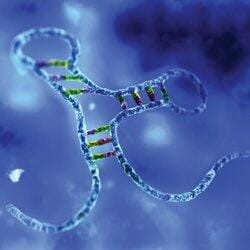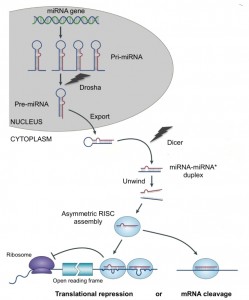A safer micro-RNA Guided Gene Therapy

Researchers from Dankook University in Korea have found a new method of introducing transgenes with therapeutic purposes. The study, published in Nucleic Acid Therapeutics, describes how targeting the passenger strand of a micro-RNA (miRNA) linked to the transgene is better than targeting the guide strand. The new system avoids the derregulated expression that the canonical method causes in the miRNA targeted endogenous genes.
miRNAs are short oligonucleotides that do not code for any protein. They are used by the cell to control gene expression. Generally, miRNAs originate from transcription of intergenic regions. This RNA acquires a hairpin, double-strand structure and is processed into ∼21 nucleotide-long noncoding RNAs by enzymatic proteins. The 21-mers are composed of a guide and a passenger strand. Typically, the guide strand is thermodinamically favored to bind the protein complex that will degrade the target messenger RNA (mRNA), but the passenger strand remains in high levels and is also used for post-transcriptional regulation.
Targeting the micro-RNA passenger strand
The targeting capacity of miRNAs has been used in gene therapy. Geneticists design vectors that include the sequence of the gene they want to introduce plus a miRNA target sequence. In this way, they can later control the therapeutic gene expression levels. The use of tissue-specific miRNAs allows also to control in which organs the exogenous gene is expressed. But some problems have been found with this tecnique. First, transgenes can act as “miRNAs sponges”, leaving endogenous genes that are regulated by the same miRNA deregulated. Second, a high transgene copy number could dilute the miRNA regulative effect on both endogenous and exogenous genes. In this paper, Sung Jin Kim, Chang Ho Lee, and Seong-Wook Lee propose to target the passenger miRNA strand instead of the guide strand. Their results confirmed an efficient control of the therapeutic gene expression, while endogenous target genes are not affected. This can be considered an improved tool for a safer gene therapy.
Source: BiologyNews


